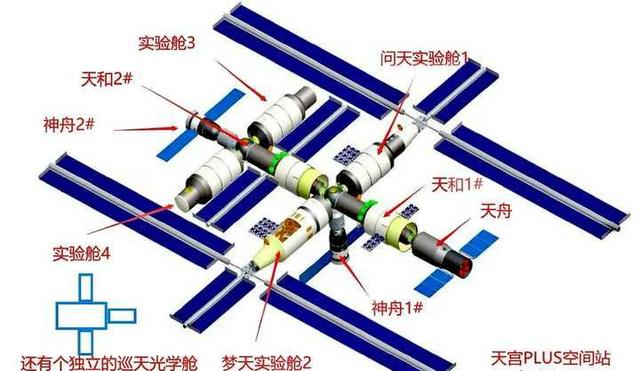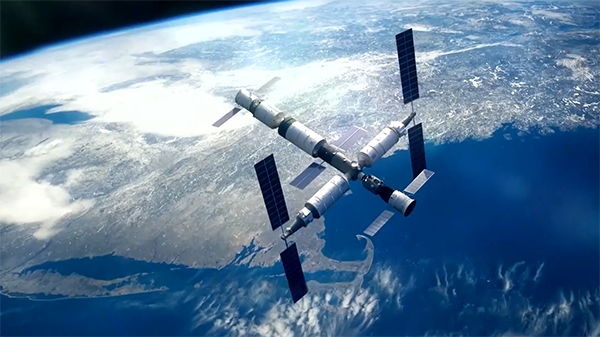The number of missions in China’s space program in recent years has reached new records, and can sometimes be overwhelming to follow. In 2021, with ~50 launches from the country’s largest space contractor (CASC), just about every week we saw a minimum of several hundred–and usually several thousand–kilograms of payload being sent from one of four launch sites of Asia’s leading space power. Among all the satellites, space science missions, and the rest, arguably the most inspirational has been the launch of the Chinese Space Station (CSS), the culmination of a decades-long effort by China to establish a long-term human presence in low-earth orbit (LEO). 2021 was a big year for the CSS, and 2022 is set to be even bigger.
Note: the Chinese Space Station is also frequently referred to as the Tiangong Space Station or just “Tiangong”. It should not be confused with the much smaller Tiangong-1 and Tiangong-2 experimental stations launched in the 2010s.
The heart of the CSS, namely the Tianhe (天和) core module was launched in mid-2021. After reaching orbit and receiving its first load of supplies, Tianhe welcomed the first cohort of taikonauts, the Shenzhou-12 crew, from June to September last year. Since then we have seen the launch of the Shenzhou-13 crew of three taikonauts, who are still on the CSS as of the time of writing.
While taikonauts would generally be expected to be working on scientific experiments and research, the first waves of Shenzhou crew on the CSS have focused on verifying key technologies and making sure that the core module of China’s first permanent orbital station is fully operational. This period has been named the “Critical Technology Validation Phase” (关键技术验证阶段), and will end with the return of the Shenzhou-13 crew to Earth in March 2022.
The return of Shenzhou-13 will mark the beginning of the “Construction Phase” (建造阶段) which will take place over the remaining 9 months of 2022, and will see the completion of the CSS. During this phase, the capabilities of the CSS will be increased significantly, with several major follow-on launches set to occur over the course of the year.
The next Tianzhou cargo shipment to the CSS (Tianzhou-4) is reportedly planned for the end of March, and the first crewed spaceflight in 2022, Shenzhou-14, will occur in May 2022. But most significantly, After the Shenzhou-14 launch, we will see the launch and deployment of the two lab modules (a.k.a experimental modules).
Tiangong’s Lab Modules
The CSS utilizes a modular T-shaped concept, with the core Tianhe module having a multi-sided radial docking node with 4 ports. Up to now, the docking ports have been used for Shenzhou crewed missions and Tianzhou cargo missions, with a robotic arm providing an option for moving around modules and assisting in docking.
In 2022, we will see the Wentian (问天) and Mengtian (梦天) laboratory modules launch from Wenchang, and dock with the Tianhe core module. This will significantly increase the pressurized and non-pressurized areas of the space station, with total size increasing from a current 20t to 60t. The new modules will provide the taikonauts with additional resources for conducting research, as well as additional storage space for experiments and supplies.
The two lab modules have a total axial length of 17.9m and a maximum cabin diameter of 4.2m. Wentian includes three parts, namely the crew working compartment, the airlock cabin, and the resource cabin, as well as a small robotic arm (more on that later), while Mengtian is divided into four parts: crew working compartment, the unpressurized cargo module, the resources cabin, and the payload cabin. Wentian will also become the main living area for the taikonauts, while Mengtian is primarily used for carrying out experiments and loading/unloading cargo.
The new modules will also provide additional means of communication, propulsion, power generation, EVA, and living quarters, with the area increasing from a current 50 cubic meters to 110 cubic meters after both Wentian and Mengtian are in place (this is a further improvement from 15 cubic meters on Tiangong-1 and Tiangong-2).
Some of the most noteworthy perks include:
- The ability to maintain continuous communications between the ground and the CSS. At the moment, the Tianhe core module is in communications with the ground >90% of the time through the constellation of Tianlian GEO satellites, but the comms antenna is sometimes masked (by the solar panels, station body, …). These communication dead zones will disappear with the additional comms capabilities of the experimental modules.
- With the new living quarters in Wentian, the capacity of the Chinese Space Station will increase to 6 taikonauts simultaneously. The normal crew will continue to be 3 taikonauts (and 6 during crew handovers). One concrete consequence of this additional capacity is that there will continuously be taikonauts in space after Shenzhou-14, while the human presence on the CSS was intermittent for Shenzhou-12 and -13.
- Wentian will include a dedicated airlock chamber for EVAs (extra-vehicular activity), and will replace the overhead airlock of the multidocking node, currently being used by the Shenzhou 13 taikonauts.
- Wentian also has the ability to act as a control center for the CSS, and acts as a backup for Tianhe-1 for certain key platforms.
- Mengtian and Wentian will bring massive 30m long solar panels, providing the majority of the power of the completed CSS. The current Tianhe-1 solar panels, which are roughly 18m long, will be redeployed by the robotic arm and installed at the endpoints of the Mengtian and Wentian modules.

Wentian will also have its own (shorter) robotic arm for experiments, which will join a larger 10m-long robotic arm already in-place on Tianhe-1. The latter is used during EVAs, to move heavy equipment around, help space station modules move from one place to another, and monitor the outside of the space station (with cameras embarked on the arm, such as the recently-installed panoramic camera manufactured by SAST Institute 804).
The arm on Wentian is around 4-5m long, and can operate separately from the longer arm on Tianhe-1, typically for use in experiments being done in the Wentian module, or otherwise can be combined into one single 15m arm.
The systems for combining the two arms were installed during a recent EVA conducted by Shenzhou-13. An adapter was installed (转接件) which allows for direct interconnection between the two arms. A suspension system (悬挂装置) was also installed permanently on the small cylindrical module of the space station. When both arms are operating separately (meaning that the adapter is not being used), the adapter would be “stored” on the suspension system.
Ultimately, at the end of the 3rd quarter of 2022, we should see a fully-assembled, operational, and highly capable Chinese Space Station in LEO, formed of Tianhe-1 and its two experimental labs. However, it may not have brought us to the end of China’s crewed space flight ambitions in 2022.
An Encore Performance: Shenzhou-15
After the arrival of the Mengtian lab module, China still has one more crewed space performance in 2022. Scheduled in late 2022, the Shenzhou-15 crewed mission should launch and dock to the (only remaining port of the) Chinese Space Station docking node. This will mean that for a time, there will be 6 taikonauts on the Chinese Space Station, just before the Shenzhou-14 crew returns to Earth.
While no details have been made public, we expect the first international taikonaut to reach the Chinese Space Station sometime in the next few years as well, likely from one of the many medium-sized space-faring nations that have become closer with China.
What Will this All Mean?
2021 was an unprecedented year for Chinese human spaceflight, and 2022 might bring further surprises. With 2 large lab modules set to be launched in the coming months, alongside 6 more taikonauts that will be sent up before the end of the year, China’s long-held crewed space ambitions in LEO are rapidly coming to fruition, and in a big way.
Moving forward, it is possible that we see the Chinese space station continue to grow in size in the coming years. Indeed, Chinese space watchers have pointed out that the Chinese Space Station’s modular nature enables it to grow beyond its currently-planned size, and that there is already a Tianhe core module on Earth at the moment, serving as a backup in case the current Tianhe-1 module in orbit did not pass the critical technology verification phase. As the latter point now seems increasingly unlikely, it is indeed possible that the spare Tianhe core module is used to extend the CSS. The below image shows what an expanded CSS might look like with an additional Tianhe, and 2 additional lab modules.

Even if that does not end up being the case, the Chinese Space Station will still represent a major milestone for China’s crewed space program, with 60t of materials and 110 cubic meters of living space. It also represents an important technological springboard for a hypothetical future lunar orbital station as the US and China both ramp up their crewed lunar programs in the mid-2020s.
For more context on the Chinese Space Station, check out our deep dive video:



